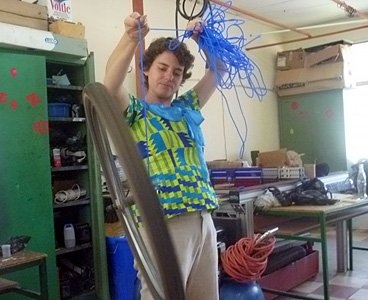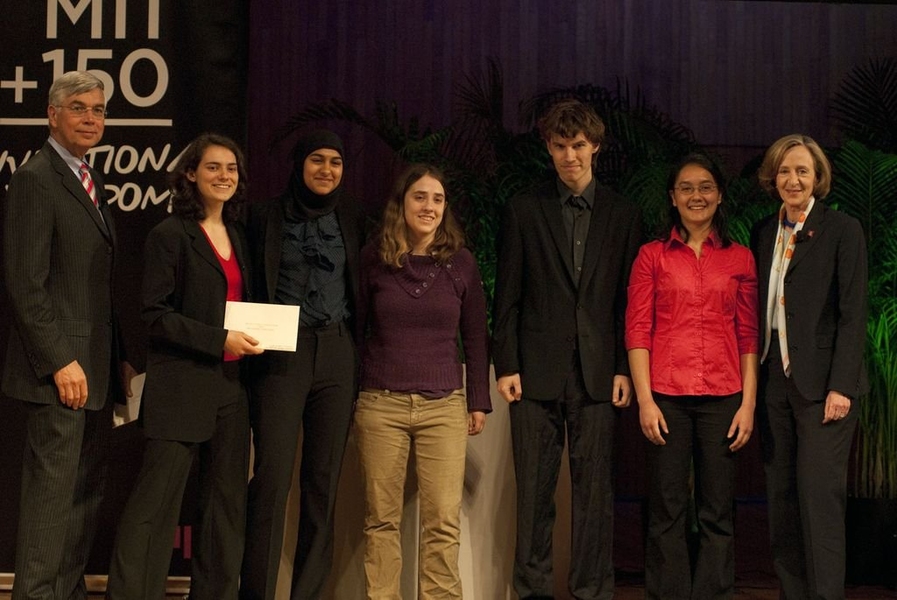What do the science of chocolate, the construction of small-scale wind turbines, negotiating with the CEO of a petroleum company, experimenting with fruit-flavored truffles and the staging of a thesis as a tragicomic play about the financial crisis in Iceland have in common? They are all the brainchild of MIT senior Anna Waldman-Brown, who was recently awarded a Fulbright Scholarship.
Waldman-Brown, a Mill Valley, Calif., native, is a joint major in physics and writing and humanistic studies. She will spend next year at the Takoradi Technical Institute and the MIT Fab Lab in Ghana, designing educational materials to help teachers and students develop energy technologies suitable for local resources and needs.
Waldman-Brown first traveled to Ghana in summer 2010 on an MIT Public Service Fellowship, where she and current sophomore Ned Burnell designed and implemented a hands-on science and engineering curriculum. Their Ghanaian students learned how to make energy-generating technologies such as small-scale wind turbines, solar panels and appliances powered by cell-phone batteries.
The pair soon realized that the project, though it had potential, would need more support to continue in their absence. It subsequently grew into their MIT Global Challenge entry — Practical Energy Network, which aims to disseminate technical knowledge and inspire locals to devise their own energy projects through extracurricular high school clubs. The entry won a $10,000 seed grant in the MIT Global Challenge, sponsored by the School of Engineering's "Global Villages" Challenge. It was also the basis for Waldman-Brown’s Fulbright proposal.
“After my Public Service Fellowship in Ghana, Ned Burnell and I realized that the science lessons we taught at the Takoradi Technical Institute couldn't continue without us — we needed to get local teachers involved in hands-on projects, and provide them with more comprehensive materials to design their own lessons,” Waldman-Brown says. “This would entail going back to Ghana for longer than a few months — so I showed up at the Public Service Center the first week of my senior year and asked about other fellowship opportunities.”
There, Alison Hynd, the fellowships and internships administrator, advised her to look into the Fulbright program. “We have worked with Anna for three years on a variety of projects, and it’s been great to experience the creativity she brings to her service work, combining a love for seemingly diverse things like physics, chocolate and writing into projects that people want to get involved with,” Hynd says.
Ghana was not Waldman-Brown’s first experience with international service projects. In summer 2009, she received a Paul and Priscilla Gray Internship from the Public Service Center to investigate an issue involving the Kallari Cooperative, an organization of indigenous Ecuadorians who produce organic chocolate for the U.S. market. The cooperative had just learned that a petroleum extraction company was planning to drill on land close to their cacao plantations. Waldman-Brown led a team encompassing a wide variety of stakeholders — including government engineers, the petroleum company’s CEO, NGOs and community leaders — to detail the potential impact in various reports, and helped with a local initiative to inform the community about living in a petroleum zone. As president of MIT's Laboratory for Chocolate Science, Waldman-Brown, in her spare time, also experimented with recipes for unusually flavored truffles.
Returning to Ecuador in January 2010 as a Public Service Fellow, Waldman-Brown looked into potential student- and alumni-led service projects with organizations that could best use the Institute affiliates’ “thinking and doing” contributions. The following summer, she worked with Brooke Jarrett ’10 and Adam Talsma ’10 to implement the first MIT alumni service trip to Ecuador, in which nine alumni worked to build capacity for the Kallari Cooperative.
“One of the things that is incredible about Anna is her ability to connect with people of all ages and to inspire mindshare among a group in support of a cause. Her scope knows no boundaries, and her absolute joy in learning and teaching is remarkable,” says Kathryn Liede, director of alumni relations at the Alumni Association, who worked closely with Waldman-Brown in the implementation of the project.
“The Public Service Center provided me with a fantastic opportunity to get out into the ‘real world’ and make a difference. An education from the Institute is all about problem solving, so it's inspiring to put these skills into practice. The best part is, all you need to get started is a good idea — and there's so much support available for implementation,” Waldman-Brown says.
Waldman-Brown’s application was supported by Global Education and Career Development Distinguished Fellowships.
Waldman-Brown, a Mill Valley, Calif., native, is a joint major in physics and writing and humanistic studies. She will spend next year at the Takoradi Technical Institute and the MIT Fab Lab in Ghana, designing educational materials to help teachers and students develop energy technologies suitable for local resources and needs.
Waldman-Brown first traveled to Ghana in summer 2010 on an MIT Public Service Fellowship, where she and current sophomore Ned Burnell designed and implemented a hands-on science and engineering curriculum. Their Ghanaian students learned how to make energy-generating technologies such as small-scale wind turbines, solar panels and appliances powered by cell-phone batteries.
The pair soon realized that the project, though it had potential, would need more support to continue in their absence. It subsequently grew into their MIT Global Challenge entry — Practical Energy Network, which aims to disseminate technical knowledge and inspire locals to devise their own energy projects through extracurricular high school clubs. The entry won a $10,000 seed grant in the MIT Global Challenge, sponsored by the School of Engineering's "Global Villages" Challenge. It was also the basis for Waldman-Brown’s Fulbright proposal.
“After my Public Service Fellowship in Ghana, Ned Burnell and I realized that the science lessons we taught at the Takoradi Technical Institute couldn't continue without us — we needed to get local teachers involved in hands-on projects, and provide them with more comprehensive materials to design their own lessons,” Waldman-Brown says. “This would entail going back to Ghana for longer than a few months — so I showed up at the Public Service Center the first week of my senior year and asked about other fellowship opportunities.”
There, Alison Hynd, the fellowships and internships administrator, advised her to look into the Fulbright program. “We have worked with Anna for three years on a variety of projects, and it’s been great to experience the creativity she brings to her service work, combining a love for seemingly diverse things like physics, chocolate and writing into projects that people want to get involved with,” Hynd says.
Ghana was not Waldman-Brown’s first experience with international service projects. In summer 2009, she received a Paul and Priscilla Gray Internship from the Public Service Center to investigate an issue involving the Kallari Cooperative, an organization of indigenous Ecuadorians who produce organic chocolate for the U.S. market. The cooperative had just learned that a petroleum extraction company was planning to drill on land close to their cacao plantations. Waldman-Brown led a team encompassing a wide variety of stakeholders — including government engineers, the petroleum company’s CEO, NGOs and community leaders — to detail the potential impact in various reports, and helped with a local initiative to inform the community about living in a petroleum zone. As president of MIT's Laboratory for Chocolate Science, Waldman-Brown, in her spare time, also experimented with recipes for unusually flavored truffles.
Returning to Ecuador in January 2010 as a Public Service Fellow, Waldman-Brown looked into potential student- and alumni-led service projects with organizations that could best use the Institute affiliates’ “thinking and doing” contributions. The following summer, she worked with Brooke Jarrett ’10 and Adam Talsma ’10 to implement the first MIT alumni service trip to Ecuador, in which nine alumni worked to build capacity for the Kallari Cooperative.
“One of the things that is incredible about Anna is her ability to connect with people of all ages and to inspire mindshare among a group in support of a cause. Her scope knows no boundaries, and her absolute joy in learning and teaching is remarkable,” says Kathryn Liede, director of alumni relations at the Alumni Association, who worked closely with Waldman-Brown in the implementation of the project.
“The Public Service Center provided me with a fantastic opportunity to get out into the ‘real world’ and make a difference. An education from the Institute is all about problem solving, so it's inspiring to put these skills into practice. The best part is, all you need to get started is a good idea — and there's so much support available for implementation,” Waldman-Brown says.
Waldman-Brown’s application was supported by Global Education and Career Development Distinguished Fellowships.








